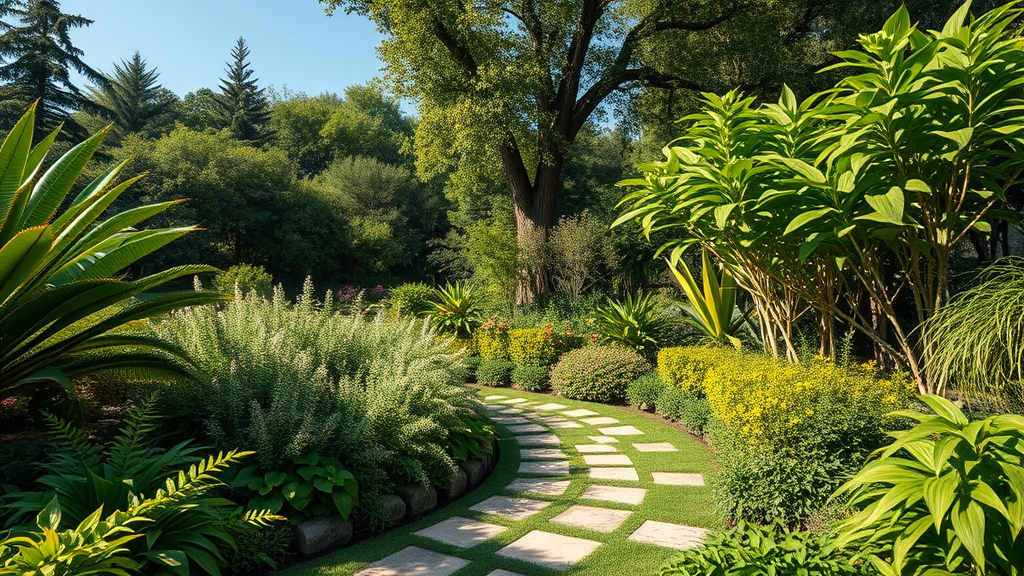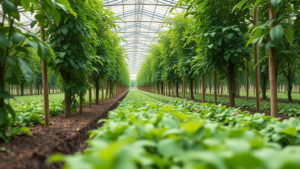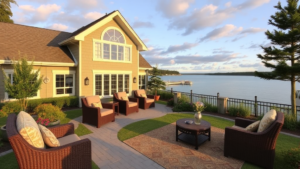Living Green Landscaping

The Benefits of Living Green Landscaping for Your Home and Community
Living green landscaping plays a crucial role in fostering a healthier environment for you and your community. By prioritizing sustainable practices, your home’s outdoor space can contribute significantly to ecological balance. Here are several key benefits to consider when incorporating living green landscaping into your home.
The Aesthetic Appeal
One of the most noticeable advantages of living green landscaping is its aesthetic appeal. A well-kept green space not only enhances your property value but also creates an inviting atmosphere. Evergreens, flowering plants, and lush lawns contribute to brighter surroundings. You can choose native plants that thrive in your area, ensuring year-round beauty.
Environmental Benefits
Living green landscaping offers a wealth of environmental benefits:
- Air Quality Improvement: Plants absorb carbon dioxide and release oxygen, improving air quality. This leads to a healthier environment for you and your neighbors.
- Temperature Regulation: Trees and green roofs help moderate temperature in urban areas, reducing the heat island effect, which is beneficial in large cities.
- Stormwater Management: Landscaping can reduce runoff and improve water quality. Rain gardens are an excellent way to manage excess rainwater and prevent erosion.
- Encouragement of Biodiversity: By planting a variety of native species, you can attract birds, butterflies, and other wildlife, fostering biodiversity in your community.
Cost Savings
Investing in living green landscaping can lead to significant cost savings:
- Reduced Water Usage: Native plants require less water and are often drought-resistant, which lowers your water bill.
- Lower Energy Bills: Strategically placed trees provide shade during hot months and act as windbreaks in cold months, leading to reduced energy costs.
- Maintenance Costs: Sustainable landscaping often requires less maintenance than conventional approaches, as native plants are adapted to local conditions.
Community Pride and Involvement
Implementing living green landscaping can enhance community pride. When neighbors see your commitment to sustainable practices, it can inspire them to act similarly. Community gardens, native plant gardens, or cooperative landscaping projects can promote engagement and teamwork among residents, benefiting the entire area.
Health Advantages
Your health can improve with well-designed green spaces. Spending time outdoors reduces stress and encourages physical activity. Living green landscaping, complete with pathways and open areas, invites you and your family to engage with nature:
- Physical Activity: Walking or gardening provides exercise, contributing to overall well-being.
- Mental Health: Nature exposure has been linked to decreased anxiety and improved mood.
- Allergy Reduction: Native plants often produce fewer allergens than exotic species.
Educational Opportunities
Living green landscaping also presents engaging educational opportunities. Children and adults alike can learn about local ecosystems, plant cycles, and sustainable practices. Consider incorporating:
- Educational Signage: Informational signs can explain the importance of each plant and its role in the local ecosystem.
- Workshops and Classes: Hosting events focused on eco-friendly gardening techniques can foster community interest and involvement.
Living green landscaping into your home and community offers numerous advantages. Not only does it beautify your surroundings, but it also contributes to environmental health, cost savings, and community engagement. To get more ideas on sustainable landscaping practices, visit EPA: Sustainable Landscaping or browse through Arbor Day Foundation for tree planting resources.
| Benefit | Description |
|---|---|
| Aesthetic | Enhances property value and creates an inviting atmosphere. |
| Environmental | Improves air quality, regulates temperature, and encourages biodiversity. |
| Cost Savings | Reduces water and energy bills, as well as maintenance costs. |
| Community | Builds community pride and fosters involvement. |
| Health | Promotes physical activity and mental well-being. |
| Education | Offers learning opportunities about ecosystems and gardening. |
Embrace the concept of living green landscaping in your outdoor spaces today to cultivate a healthier, more beautiful environment for everyone!
Sustainable Materials to Use in Your Landscaping Projects
Creating sustainable landscapes is not just about aesthetics; it’s about making choices that benefit the environment. When embarking on landscaping projects, using sustainable materials can significantly reduce your ecological footprint. Let’s explore some eco-friendly materials that you can incorporate into your landscaping efforts.
Recycled Materials
Recycled materials are a fantastic choice for sustainable landscaping. They prevent waste by repurposing items that would otherwise be discarded. Here are a few options:
- Recycled Concrete: Ideal for walkways, patios, and retaining walls, recycled concrete can save you money and reduce demand for new materials.
- Reclaimed Wood: Using old timber for fences, decks, or garden beds adds character while reducing the need for new lumber.
- Glass Mulch: An attractive, colorful alternative to traditional mulch, glass mulch is made from recycled bottles and can enhance your garden’s appearance.
Native Plants
Choosing native plants is one of the most sustainable decisions you can make for your landscaping. These plants are adapted to the local climate, soil, and pests, requiring less water and fewer chemicals. Benefits include:
- Lower Maintenance: Native plants require less care and thrive in local conditions.
- Support for Wildlife: They provide habitat and food for local wildlife, including beneficial pollinators.
Permeable Paving
Traditional paving can lead to water runoff, which can cause erosion and water pollution. Permeable paving allows water to soak through, which helps replenish groundwater. Some materials to consider include:
- Permeable Concrete/Asphalt: These materials allow water to pass through, reducing runoff.
- Gravel and Stone: Both are excellent options for driveways and walkways that promote drainage while providing a natural look.
Sustainable Stone and Rock
When choosing stone for your landscaping features, look for local, sustainable options. Using locally-sourced stone reduces transportation emissions and supports local suppliers. Additionally:
- Natural Stone: Materials like flagstone and slate can be used for patios, walls, and steps, providing durability and timeless beauty.
- Recycled Stone: Crushed brick or stone can be reused in pathways or as base material for construction, giving a rustic yet sustainable touch.
Bioswales and Rain Gardens
Features like bioswales and rain gardens is an excellent way to manage stormwater on your property. These areas collect rainwater, allowing it to filter back into the ground instead of running off into storm drains. Here’s what to include:
- Native Plants: These should be part of the bioswales and rain gardens to promote water absorption and support local wildlife.
- Soil Amendments: Adding organic materials can improve drainage and promote healthier plant growth.
Eco-Friendly Mulch Options
Mulch is commonly used in landscaping, but not all types are sustainable. Some alternatives include:
- Bamboo Mulch: Fast-growing and renewable, bamboo provides excellent moisture retention.
- Coconut Coir: A byproduct of coconut harvesting, coir is biodegradable and helps retain soil moisture.
Sustainable Irrigation Systems
Investing in sustainable irrigation can make a real difference in conserving water. Options to consider include:
- Drip Irrigation: This system delivers water directly to the roots, minimizing waste.
- Rainwater Harvesting Systems: Collecting rainwater for irrigation reduces reliance on municipal water supplies.
By integrating these sustainable materials into your landscaping projects, you enhance both the beauty of your space and your environmental responsibility. For more in-depth information on sustainable landscaping, visit sites like EPA Sustainable Landscaping or NWF Sustainable Landscaping.
These sustainable practices will not only beautify your outdoor spaces but also make a positive impact on your local environment. Remember, every small step towards sustainability counts!
How to Create a Wildlife-Friendly Garden with Living Green Principles
Creating a garden that nurtures wildlife while also adhering to living green principles can greatly enhance your outdoor space. Following eco-friendly methods not only benefits the environment but also brings joy and beauty to your home. Embrace the idea of a wildlife-friendly garden with these essential tips.
Understand Your Local Ecosystem
To effectively create a wildlife-friendly garden, start by understanding the local ecosystem. Observe what types of wildlife are native to your area. The plants and animals that inhabit your neighborhood will influence your choices in landscaping. Native species are better adapted to the local climate and soil conditions and require less maintenance.
Choose Native Plants
Selecting native plants is crucial for a thriving wildlife garden. These plants provide food and habitat for various creatures, including birds, insects, and small mammals. Here’s a list of benefits of using native plants:
| Benefit | Description |
|---|---|
| Support Wildlife | Native plants attract pollinators such as bees and butterflies. |
| Lower Maintenance | These plants need less water and care once established. |
| Enhance Biodiversity | They help maintain healthy ecosystems. |
Consider adding shrubs, perennials, and trees that are well-suited to your region’s soil and climate conditions. For recommendations, check out Native Plant Society of North America which has extensive resources.
Create Natural Habitats
Wildlife needs shelter and food sources to thrive. You can create different habitats in your garden by incorporating various elements:
- Birdhouses and Feeders: Install birdhouses to provide nesting spaces. Feeders can keep birds nourished during colder months.
- Water Sources: A small pond or birdbath can be an excellent water source for wildlife. Ensure it has shallow edges for easy access.
- Compost Pile: A composting station can attract beneficial insects and eliminate waste, promoting a healthy garden.
These habitats will give animals a safe haven, encouraging them to visit your garden regularly.
Use Sustainable Practices
Sustainable practices is essential when creating a wildlife-friendly garden. Anti-pesticide approaches can help protect beneficial insects while conserving other wildlife. Here are some tips to consider:
- Natural Pest Control: Instead of chemicals, use companion planting, herb-based sprays, or introduce natural predators to control pests.
- Organic Mulching: Use organic materials for mulching, such as shredded leaves or wood chips, to maintain soil health and moisture.
- Rain Gardens: Design a rain garden to capture rainwater runoff. This technique reduces erosion and provides more water for your plants.
Adopting these methods helps create a healthier environment that promotes biodiversity.
Embrace Diversity in Planting
Diverse plant life will attract a wider variety of wildlife to your garden. Among the plants, include a mix of flowering and non-flowering varieties to provide year-round interest. Here are some suggestions:
- Flowers: Plant flowering species such as coneflowers, black-eyed Susans, and milkweed to attract pollinators.
- Grasses: Add native grasses to provide cover and nesting areas for ground-dwelling birds.
- Fruits and Berries: Plant native berry bushes, like elderberry or serviceberry, to feed birds and other wildlife.
Having plants that bloom at different times can ensure there is always something for local wildlife.
Maintenance With Care
Maintaining your wildlife-friendly garden should align with sustainable practices. Limit disturbance to wildflowers, and consider mowing less frequently to allow plants to go to seed, providing food for birds. In the fall, leave leaves on the ground to provide cover for insects and other critters.
Final Thoughts
Creating a wildlife-friendly garden requires thoughtful planning and commitment to living green principles. By selecting native plants, creating habitats, and embracing sustainable practices, you can contribute to a healthier ecosystem. You will enjoy a more beautiful and lively outdoor space while assisting local wildlife.
For more inspiration, visit Wildlife Habitat Council to learn about their initiatives and get ideas for creating your own wildlife-friendly garden.
Water-Efficient Practices for Beautiful Living Green Landscapes
Creating a sustainable and beautiful living green landscape doesn’t just enhance the beauty of your outdoor space; it can also significantly reduce water usage, preserving this precious resource. Implementing water-efficient practices ensures that your landscape thrives, while also being eco-friendly.
Choosing Native Plants
Native plants are adapted to your local climate and soil conditions, requiring less water and maintenance than non-native species. They have evolved to withstand drought conditions, making them an ideal choice for water-efficient landscaping.
- Less Maintenance: Native plants need less care, which saves you time and effort.
- Supports Local Wildlife: They provide habitat and food for local birds, bees, and other wildlife.
- Soil Adaptation: Their roots help prevent soil erosion.
Implementing Xeriscaping
Xeriscaping is a landscaping method that reduces or eliminates the need for irrigation. This technique involves various strategies, including soil amendment, zoning plants based on their water needs, and using mulch to retain moisture in the soil.
- Soil Amendment: Enhance your soil with organic matter to improve its water-retention ability.
- Plant Zoning: Group plants based on their water needs. This ensures efficient irrigation.
- Use of Mulch: Organic mulches help to keep the soil moist, reducing the frequency of watering.
Installing Drip Irrigation Systems
Drip irrigation delivers water directly to the roots of the plants. This targeted approach minimizes evaporation and ensures that water is used efficiently.
- Water Savings: Drip systems can reduce water consumption by 30-50% compared to traditional sprinklers.
- Less Weed Growth: By watering directly at the root, you discourage weed growth.
- Flexibility: Systems can be customized to meet the needs of various plant zones in your garden.
Collecting Rainwater
Rainwater harvesting is a sustainable practice that allows you to collect and store rainwater for landscaping purposes. This not only supplements your water supply but also decreases stormwater runoff, benefiting your local environment.
To set up a rainwater collection system:
- Install gutters on your home’s roof.
- Use rain barrels to collect the water.
- Ensure you have a filtration system to keep the water clean.
Choosing the Right Time to Water
Watering your landscape at the optimal times can greatly enhance water efficiency. Early morning, when temperatures are cooler, is the best time to water. This reduces evaporation and helps ensure that your plants absorb water effectively.
Additional tips include:
- Watering Deeply: This encourages deep root growth.
- Check Soil Moisture: Use a moisture meter to determine when watering is truly needed.
- Follow Local Regulations: Be aware of any watering restrictions in your area.
Creating Hardscapes
Integrating hardscapes like patios, walkways, and retaining walls can help reduce the amount of grassy areas that need watering. These features often require little to no water and can add beauty and functionality to your living green landscape.
Consider these materials for your hardscapes:
- Permeable pavers to allow water drainage and reduce runoff.
- Natural stone for a rustic feel.
- Decorative gravel for a low-maintenance, attractive surface.
By implementing these water-efficient practices, you can cultivate a stunning living green landscape while conserving water. For further information and resources, consider visiting EPA Water Reuse or Water-Wise Plants. Together, we can make a positive impact on our environment, ensuring that our landscapes remain beautiful and sustainable for years to come.
Tips for Maintaining Your Living Green Landscape Year-Round
Conclusion
Embracing living green landscaping not only enhances your home’s aesthetic appeal but also contributes to a healthier environment for your community. By incorporating sustainable materials, you create a foundation for durability and eco-friendliness in your landscaping projects. These choices offer enduring benefits, including reduced environmental impact and lower maintenance costs over time.
Creating a wildlife-friendly garden adds another layer of ecological balance, inviting beneficial species that support your local ecosystem. By selecting native plants and providing habitats, you can transform your garden into a haven for birds, butterflies, and other wildlife, enriching both your yard and the surrounding area.
Adopting water-efficient practices is crucial in today’s world of fluctuating climates. Implementing techniques such as drip irrigation and rain gardens not only conserves water but also helps maintain vibrant, healthy plants. This creates a landscape that thrives while minimizing waste.
Regular maintenance tips, like seasonal pruning and mulching, ensure your living green space remains beautiful year-round. By staying proactive with upkeep, you can enjoy a lush landscape that enhances your property’s value and invites admiration.
Transforming your outdoor space with living green landscaping is a rewarding journey. You take an active role in promoting sustainability, conserving crucial resources, and nurturing biodiversity. Ultimately, you contribute to a greener future, enriching your life and the lives of those around you while creating a peaceful retreat in your backyard.


